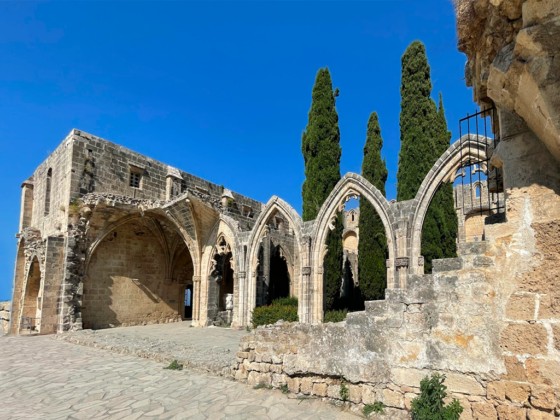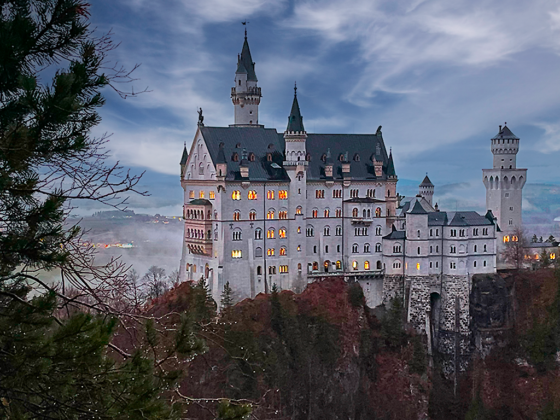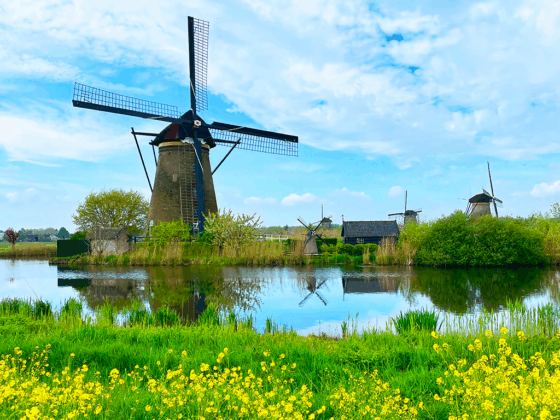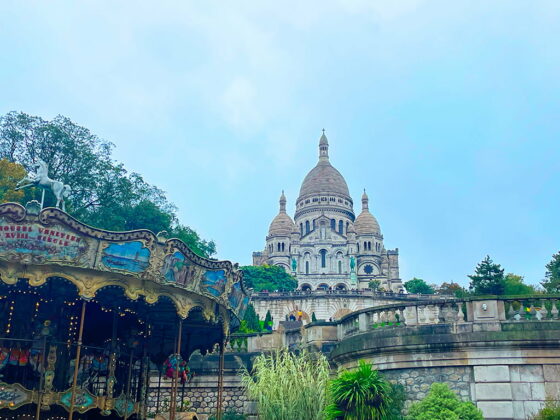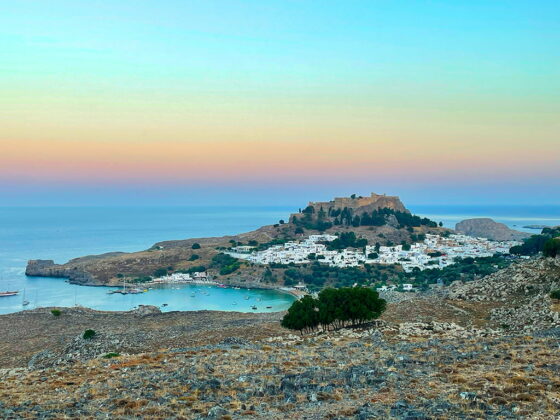Provence, a historical region in the south of France, is a place full of villages to discover and landscapes to admire. Many see it as a summer destination only but, thanks to its mild climate and bright blue skies all year round, Provence offers a lot even during the low season. It is a perfect place for those who want to travel by car and only have a few days to spare.
Our mini-tour, 1300 km long, lasted four days. If you are curious to find out more, here are the cities we visited.
Map
Inside each section dedicated to a city there is a relative map with all the points of interest to visit in a one-day itinerary. Scroll down and see them all!
Day 1: Avignon
We begin our tour of Provence from Avignon, called the ‘city of the popes’. Its historical centre, all in Gothic-Medieval style is surrounded by 5 km of still well-preserved walls and can be visited entirely on foot in one day.
Tips for Trips: it is best to park your car outside the walls. There are two large car parks connected to the centre by free shuttles: Parking des Italiens (where we parked), to the north-east of the old town and easily accessible on foot from the centre, and Ile Piot, which is part of Ile de la Barthelasse.
We cross the walls to enter the city centre and head towards the Rocher des Doms Park, perched on a hill. From here there is an excellent view of the Rhone River, the Pont d’Avignon and part of the old town. A good starting point for a peek at what the city has to offer.
We head towards the Pont de Saint-Bénezet, also known simply as the Pont d’Avignon.
Tips for Trips: here you can buy a single ticket for entry to both the bridge and the Palace of the Popes by choosing the time of your visit. This way you avoid the endless queue at the entrance and can enter the Palace directly.
It is located on the Rhone River and originally led to the town of Villeneuve, on the opposite side of the river. It was built in the 12th century and its length was 900 metres consisting of 22 arches. The rush of the river repeatedly damaged the bridge structure, which was promptly restored until the umpteenth flood in 1668. Since then, only four arches remain.
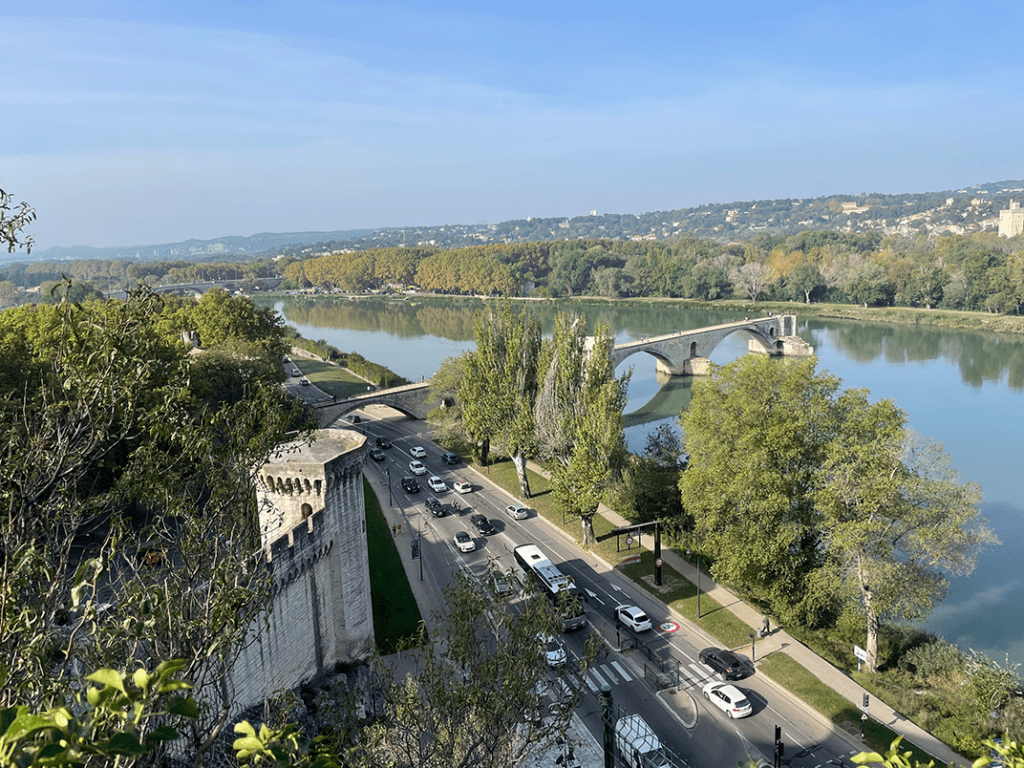
We walk up the hill and arrive at Place du Palais, where the Notre Dame Church – the cathedral of Avignon – and the imposing Palais des Papes are located, which makes everything else around it look like a disfigurement, both in terms of its size and its features. We move on as we have booked the tour of the Palais in the afternoon to treat ourselves to a stroll around the centre in the warmer hours.
We move on to Place de l’Horloge, the main square of Avignon, which owes its name to the large clock above the great town hall: theHotel de Ville. The square is full of bars and cafés – perhaps too touristy – and is enlivened by an ancient horse-drawn carousel and stalls of local artisans. Next to the town hall is the Opéra Theatre built in the 19th century.
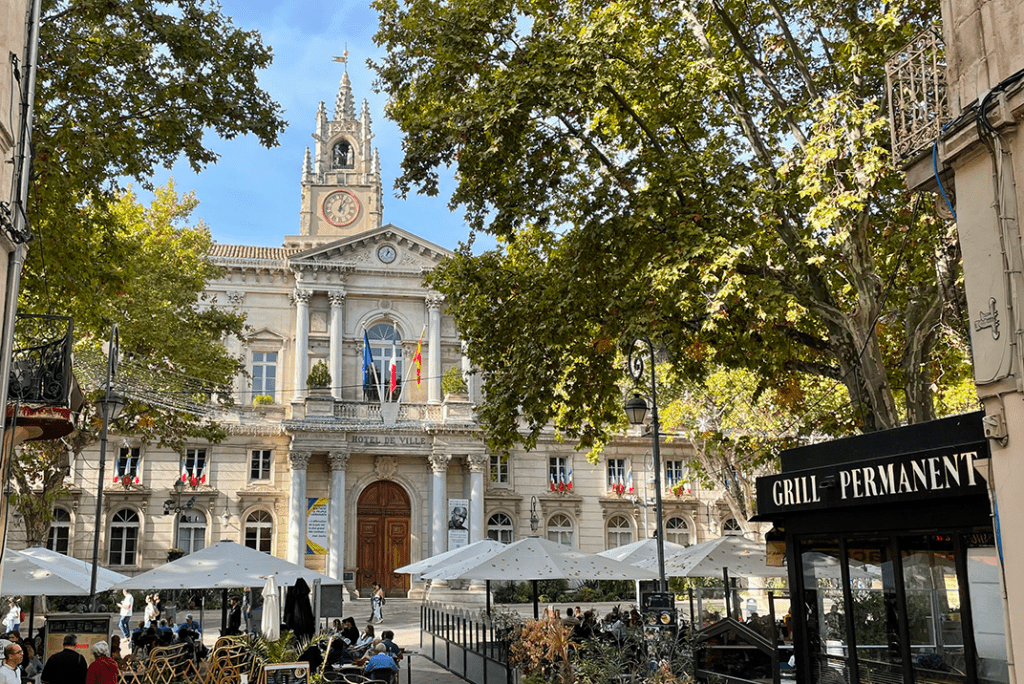
A short distance away, on rue Collége du Roure, is Palais du Roure, dating from the 15th century. It was a house built for a Florentine banking family, but has been converted into a cultural centre. We don’t enter the palace but linger to wade through the atmospheric entrance and courtyard.
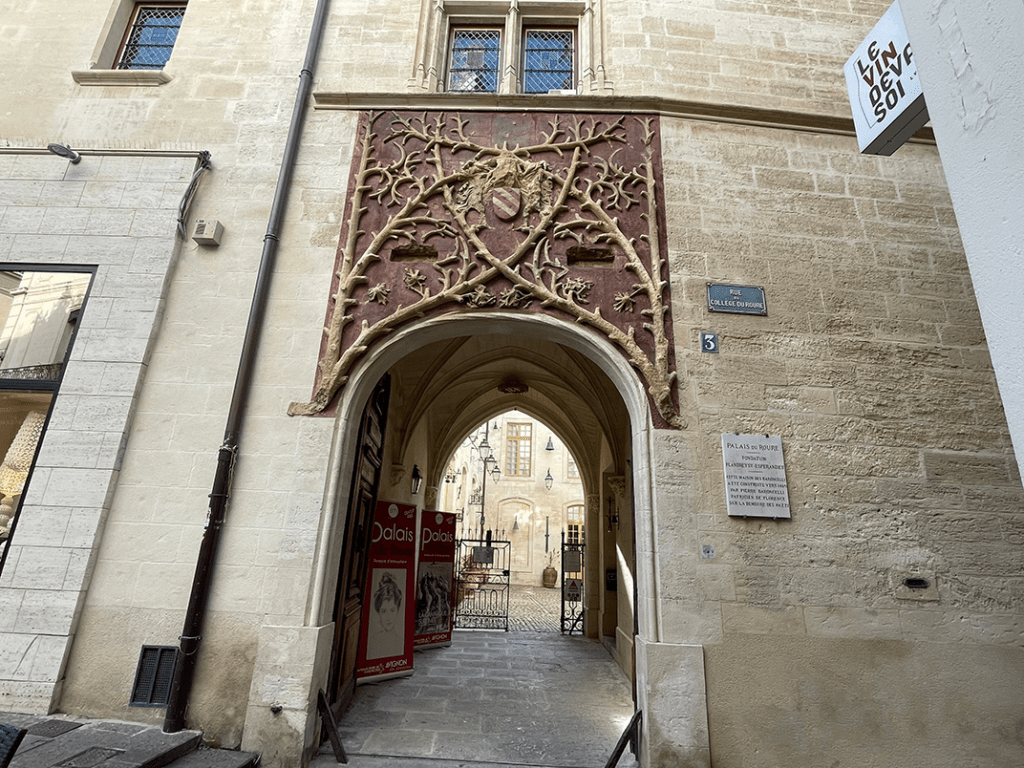
We move on to Place Pie where the market, Les Halles, is located, inside a building covered in vegetation – known as mur végétal because of its size: 30 metres wide by 12 metres high – in which Provençal and French gastronomic specialities are to be found. Les Halles is only open in the morning so if you are a market lover, the advice is to start here as the first stop of the day to enjoy the market in peace.
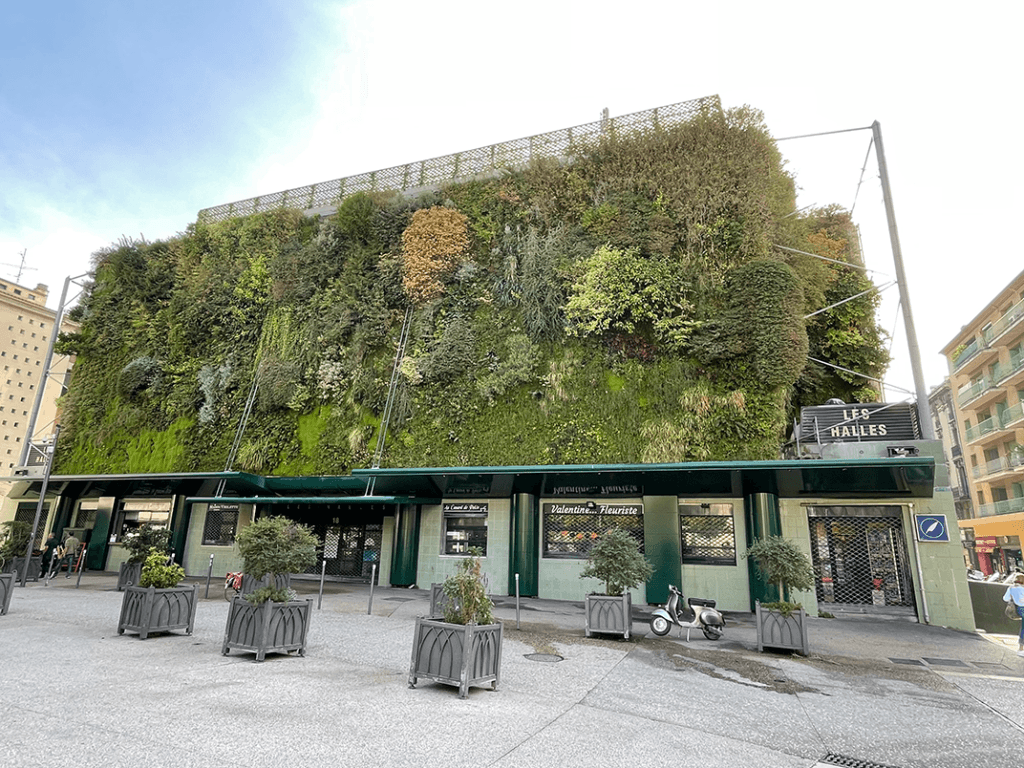
At the centre of Place Pie stands the Tower of Saint Jean, built during the 16th century for the Brotherhood of Saint John of Jerusalem. Initially, this tower separated the square from the Jewish quarter, but during the 19th century, the buildings bordering the tower were demolished. Instead, the tower was reinforced and a clock installed on its façade.
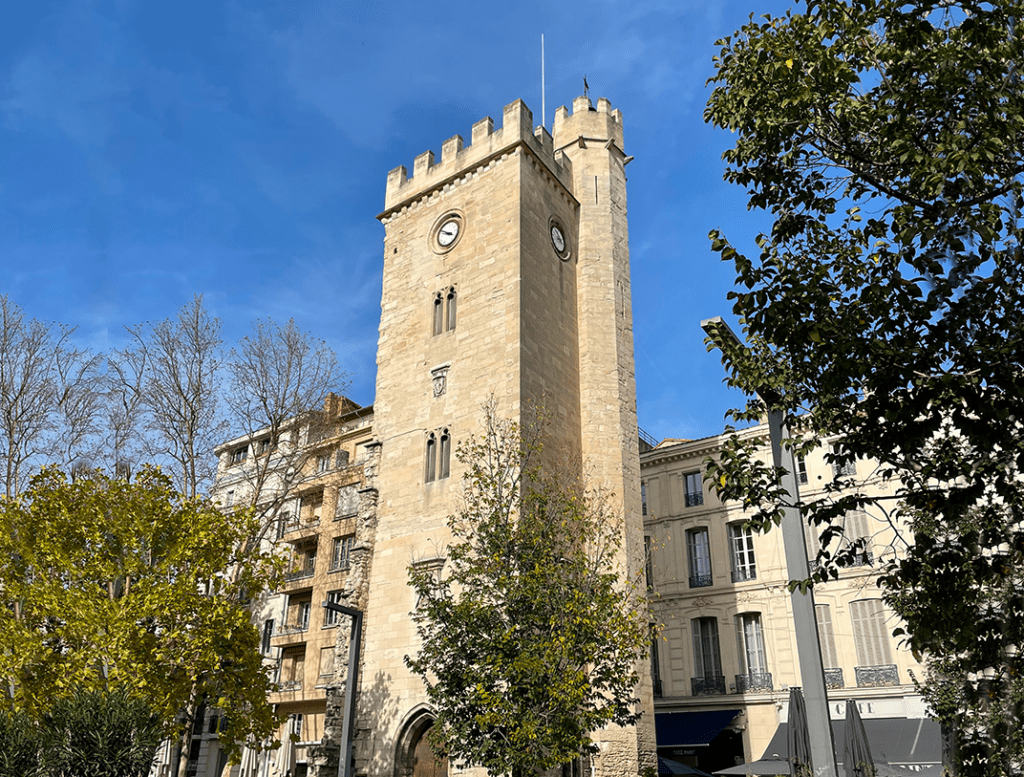
We wander through the narrow streets of the centre, full of life and more or less vintage shops. We get a little curious and lose ourselves in the narrow streets. We cross Place Saint-Didier with its church of the same name – dating back to the mid-14th century – which reflects the Gothic style of the entire city of Avignon. We go as far as Place des Corps Saints where many small café tables occupy the small open space. In the background is a huge church: the Church of the Celestines built at the end of the 14th century on the initiative of the antipope Clement VII and King Charles VI.
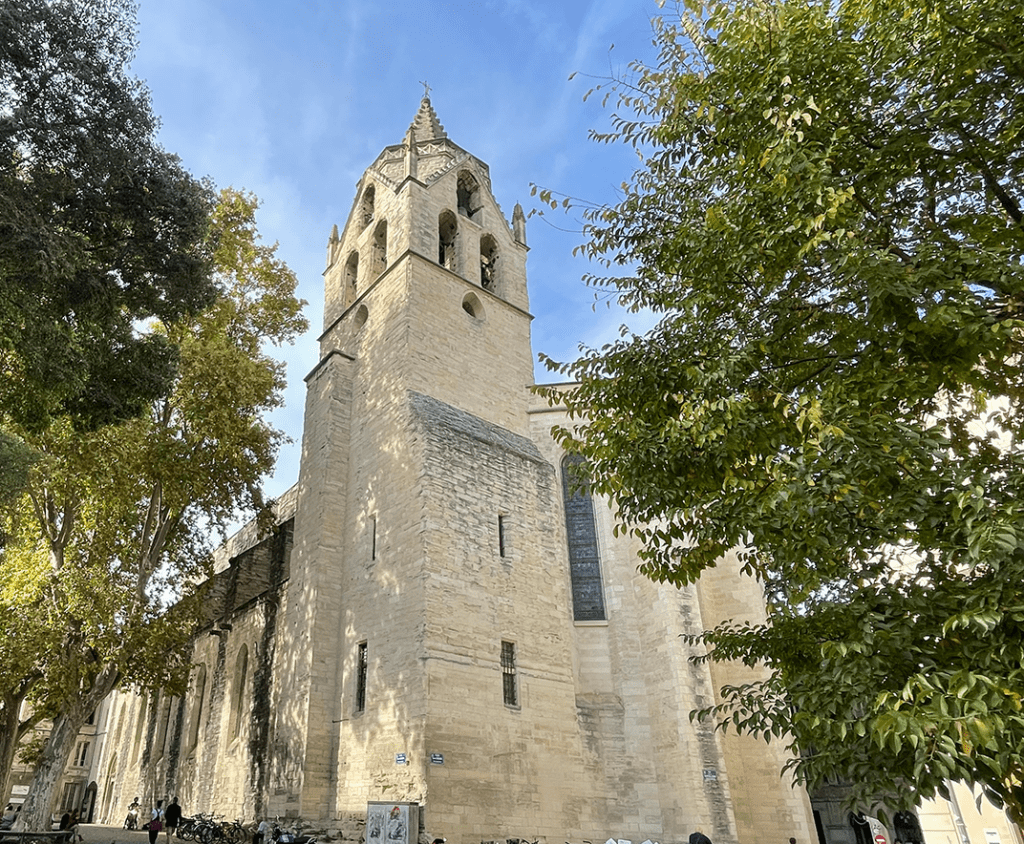
We head towards the main street, but make a stop at the beautiful Saint Martial Church, a large church nestled in a small, well-kept city park away from the hustle and bustle of the city centre, great for taking a break. Built in the 14th century as a monastery and school for the Benedictine order, it was abandoned during the French Revolution and converted into a natural history museum until the early 19th century. Today it is a Protestant church. On the outside, the ruins of the old Saint Martial cloister can be seen in the Agricol Perdiguier square.
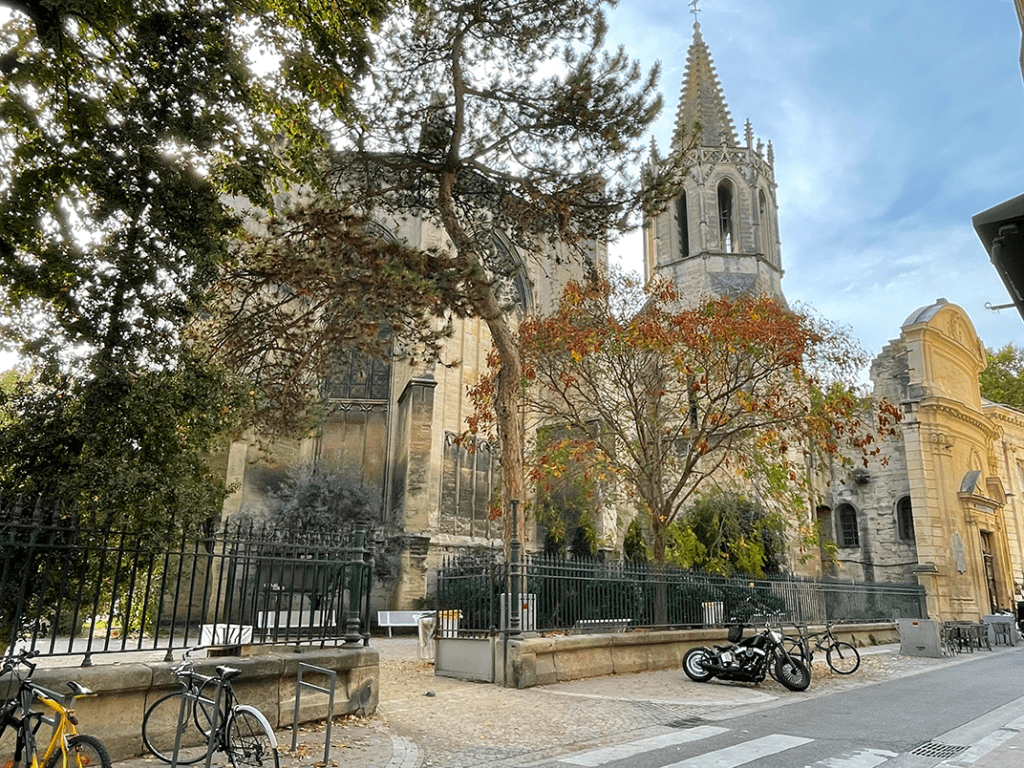
We walk up Rue de la République and make a small diversions to visit the 14th-century Basilica Saint-Pierre d’Avignon. The entrance faces the tiny Place Saint-Pierre and seems almost hidden. The large main façade, in Gothic style decorated with two small towers on either side, creates a very striking contrast to the small square in which it stands. Inside, the contrast is still evident, the basilica consists of a central nave almost 26 metres long by almost 10 metres wide and the total height is 15 metres.
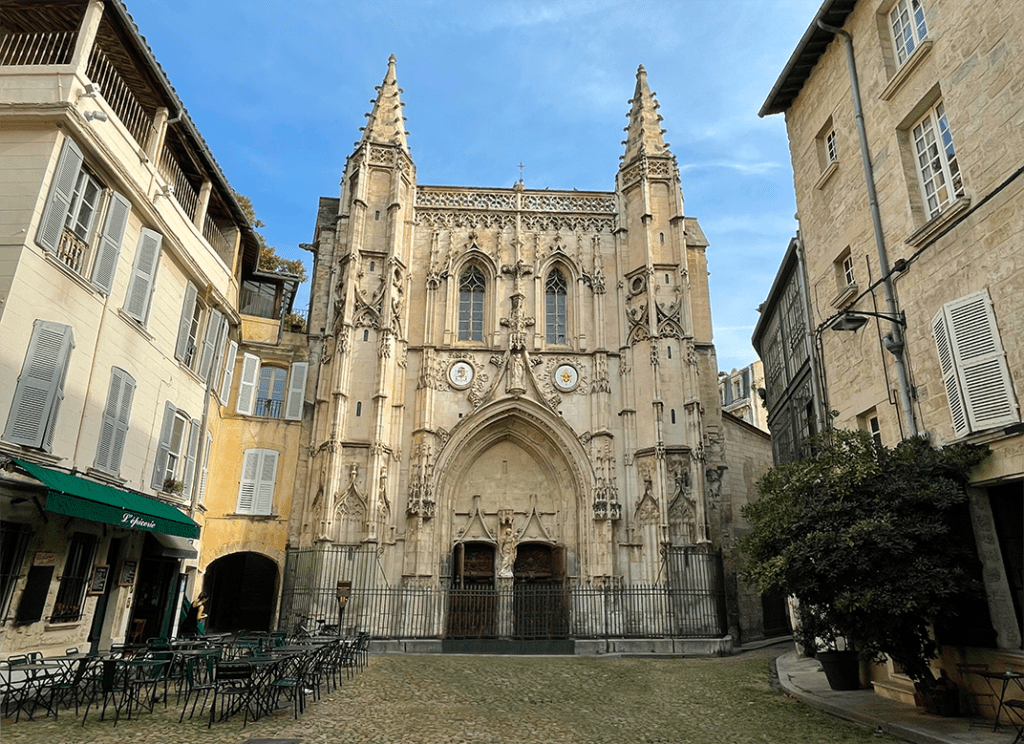
To return to Place du Palais, we cross the charming and beautiful Rue de la Peyrolerie. This small street, carved into the rock, runs alongside the Palais des Papes and passes under one of its buttresses.

The Church of Notre Dame is located on a rock – the so-called Rocher des Doms – and is accessible from the square via a long flight of steps divided on two sides. It was built in the 12th century but at the beginning of the 15th century the original bell tower collapsed so the present one was erected. This bell tower also represents the exterior façade of the church and is equipped with a gigantic 35-bell carillon. At the top of the bell tower is the statue of the Virgin Mary, which from below looks normal-sized but is 6 metres high and weighs 4500 kilos. Inside Notre Dame, the structure is divided into four bays covered by barrel vaults.
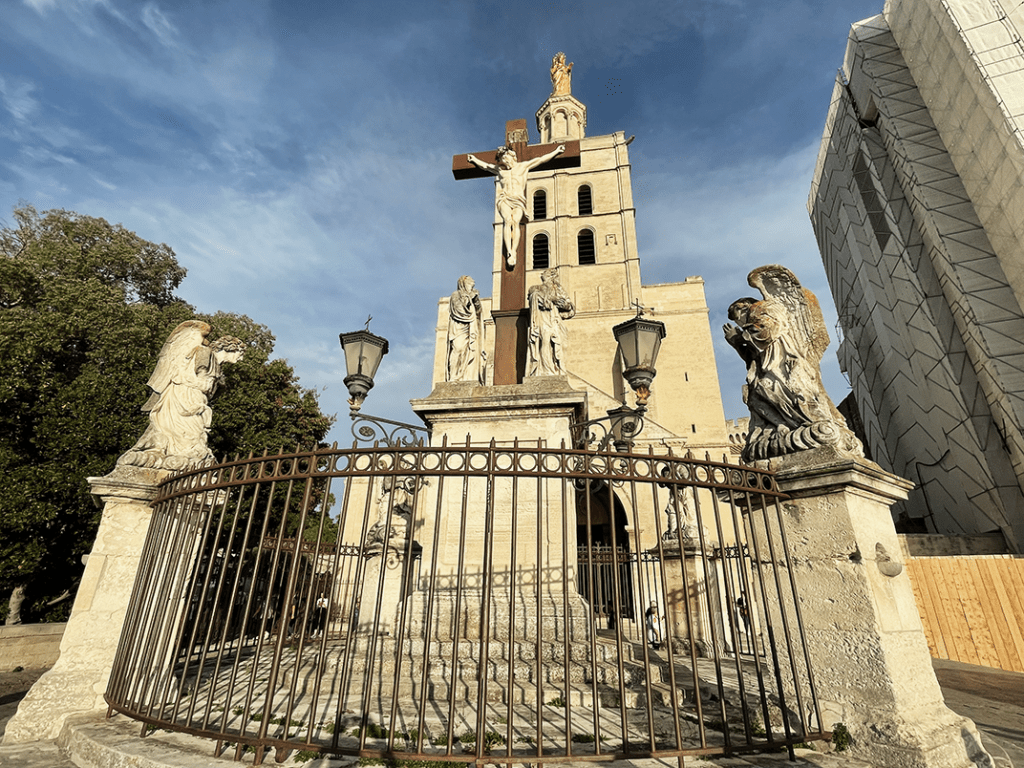
It is the turn of the Palais des Papes, one of the largest and most important medieval Gothic buildings in Europe, proclaimed a World Heritage Site in 1995. The palace, which stands on the site of the old bishop’s palace, was built by Pope Benedict XII and consists of two adjacent buildings: Vieux Palais characterised by the Tower of Angels, and the Palais Neuf with the papal flats and the Chapelle Clementine from which there is access to the palace roof. Inside, none of the 25 rooms retains its original furnishings, but thanks to the multimedia tablet tour – included in the entrance ticket – it is possible to view the rooms with their decorations and furniture as they were furnished at the time. In addition, a treasure hunt is offered – for the little ones, they say – in which in each reconstructed room you have to find a virtual object in which a coin engraved with the effigy of the popes is hidden. If you find them all at the end of the tour you win the diploma of history hunter, needless to say the competition is on!

In the evening, on our way back to the car, we walk along the entire centre following the walls and the beautifully lit ramparts. In total, there are almost 5 km of 14th-century walls with 39 towers and 7 main gates. We only walk along the southern part, starting from the Porte de la République to the Port de Saint-Lazare.
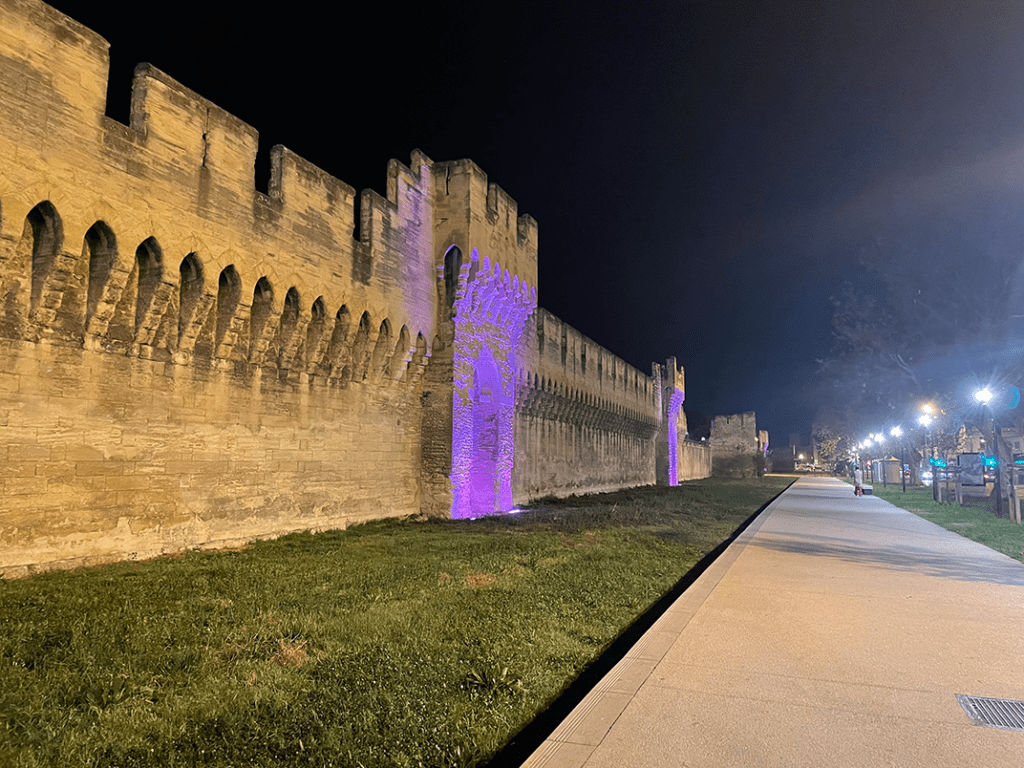
Day 2: Marseille
Our second stop in Provence is Marseilles. A controversial city, with no half-measures, about which I have heard a lot of opinions and stories – true or alleged – but if one thing is certain, it is that you either love it or you hate it… and me, I loved it immediately. It is a seaside city, multiethnic, lively and colourful, very different from the other cities on the Côte d’Azur and more similar in vocation to my city of the heart.
Upon arriving in the city, we park at the Q-Park Vieux Port and this is where our itinerary begins. The Old Port of Marseille is the heart of the city, teeming with life and immediately catapulting you into the atmosphere of the place. After the redevelopment work of architect Norman Foster, a large area was made pedestrianised and theOmbrière, a large mirrored canopy, was installed. On still warm autumn days, it is pleasant to take a walk along the quays with the sea as a companion.
We walk up Place Villeneuve-Bargemon, a large pedestrian square shaded by ancient olive trees and plane trees created at the beginning of 2006 during the extension of the City Hall. Its beauty lies in its location: it offers a perspective from the Old Port to Notre-Dame de la Garde, creating a meeting point between the Port, the Town Hall and the Hotel-Dieu.
A little further on, we visit the Notre-Dame-des-Accoules Church, one of the oldest in the city, built on the ruins of an ancient temple dedicated to Minerva during the 11th century. The juxtaposition of so many different styles due to the various destructions and reconstructions is peculiar. All that remains of its origins is the bell tower, now a listed Historical Monument. The courtyard and crypt are worth a visit.
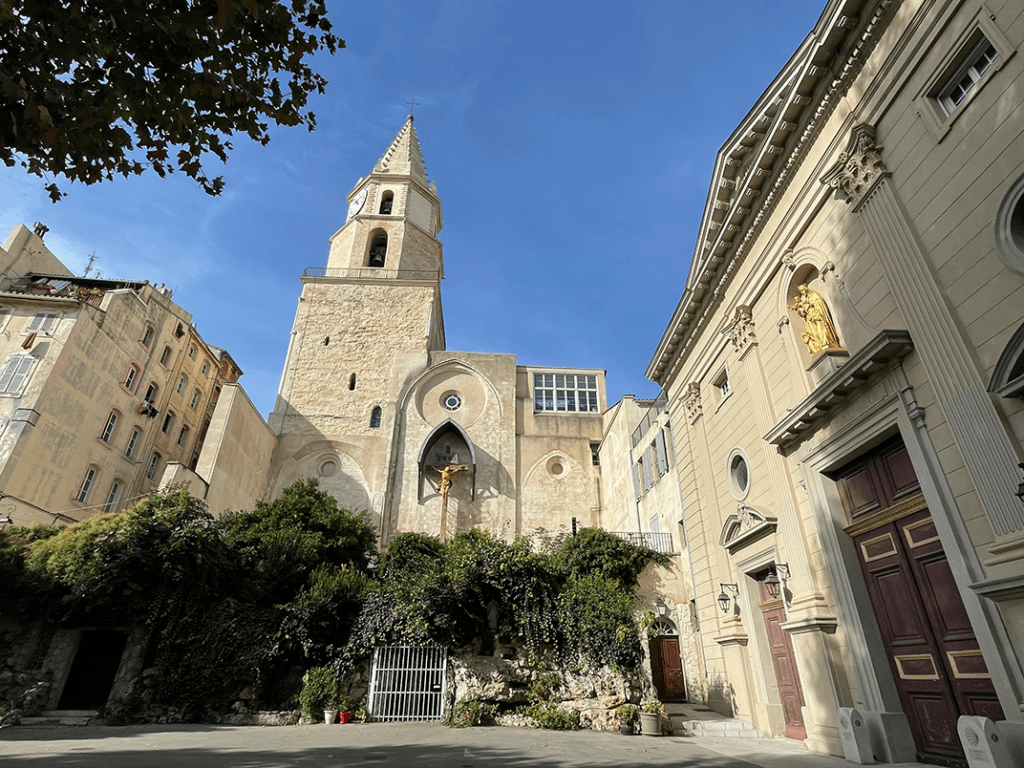
Proceeding along Rue Caisserie, we come to the Eglise Saint Laurent, also known as the fishermen’s church. It is in the Provençal Romanesque style with simple lines, an octagonal bell tower and pink freestone masonry. The entrance door is in the middle of the long side and gives onto a small square overlooking the entire port and looking towards Notre Dame de la Garde and Fort St. Jean to which it is connected by a footbridge.
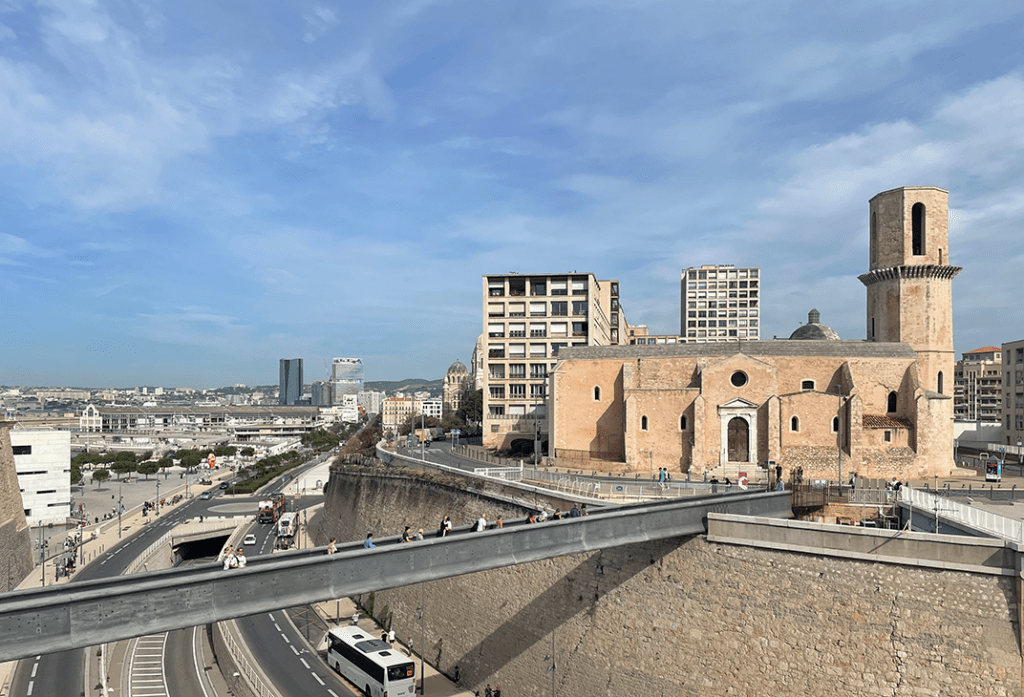
We cross the footbridge and enter Fort St. Jean, a fortification built in 1660 by Louis XIV of France opposite Fort Saint-Nicolas on the opposite side of the port. The structure consists of several buildings on two levels. On the lower level is King René’s Tower, 28.50 metres high and consisting of four rooms served by a spiral staircase of 147 steps opening onto the roof terrace. Also belonging to this level are the Saint-Jean Chapel and a small square from which the gallery of the cannon ascent starts, passing under the officers’ gallery and ending on the upper level. On the upper level is the Round Lantern Tower that served as a lighthouse, the Officers’ Gallery and the demolished Old Barracks where the remains of a mill and an oven are still visible. All around the fort you can walk along the walls of the fort and the view of the sea and the coastline is very impressive.
We cross the second footbridge connecting the fort with the Mucem – Museum of European and Mediterranean Civilisations – a large black block of honeycomb concrete. We only pass through it but the roof offers a place to rest and eat with a view.
We head for the Cathedral of St Mary Major – one of the largest cathedrals in France – built in the second half of the 19th century. Surprising for its neo-Byzantine style, it has several domes and is characterised by twin towers on its white and green striped stone façade.
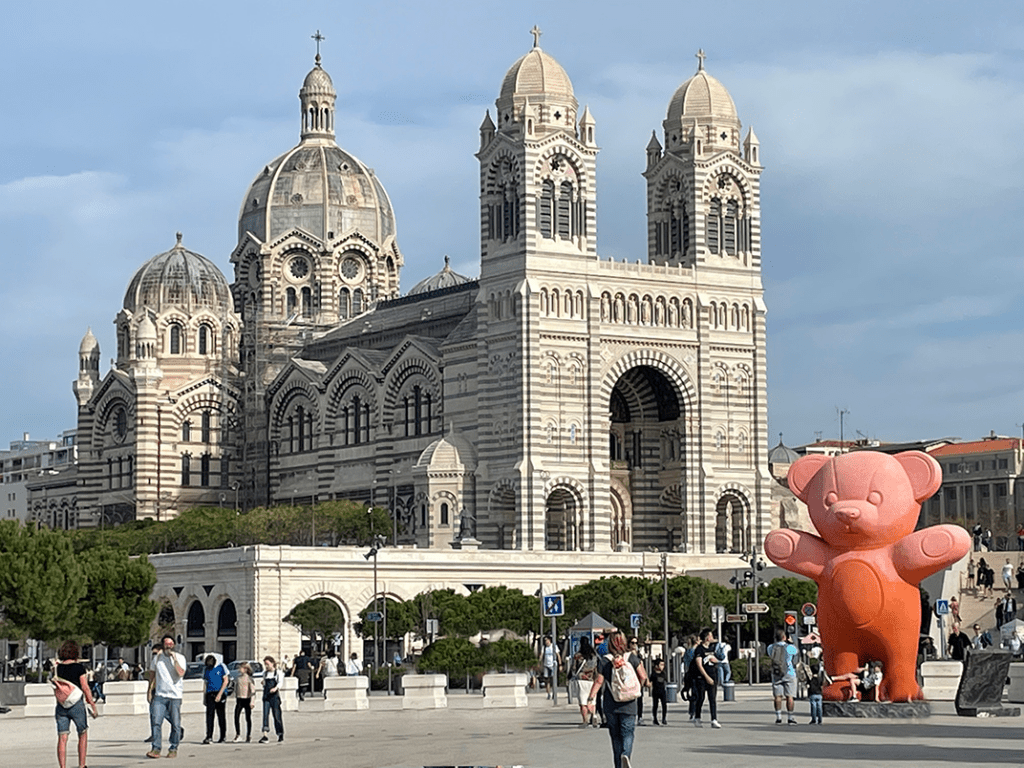
It is almost lunchtime and we move on to Le Panier, Marseille’s neighbourhood par excellence, the true heart of the ancient city. This is where the first Greeks settled when they arrived. It was the fishermen’s quarter, then came the waves of immigrants and, over time, smuggling and the underworld. It has continued to be a ‘difficult’ neighbourhood, beautiful, but run-down and dangerous. In 2013, with its candidature as European Capital of Culture, the district opened up to tourism, maintaining its popular character but with an alternative, hippie accent. Strolling through its alleyways, we lose ourselves in multi-ethnic restaurants and interesting places, an infinity of ateliers and boutiques, vintage shops and craft workshops. The neighbourhood absolutely enchants us with its liveliness.
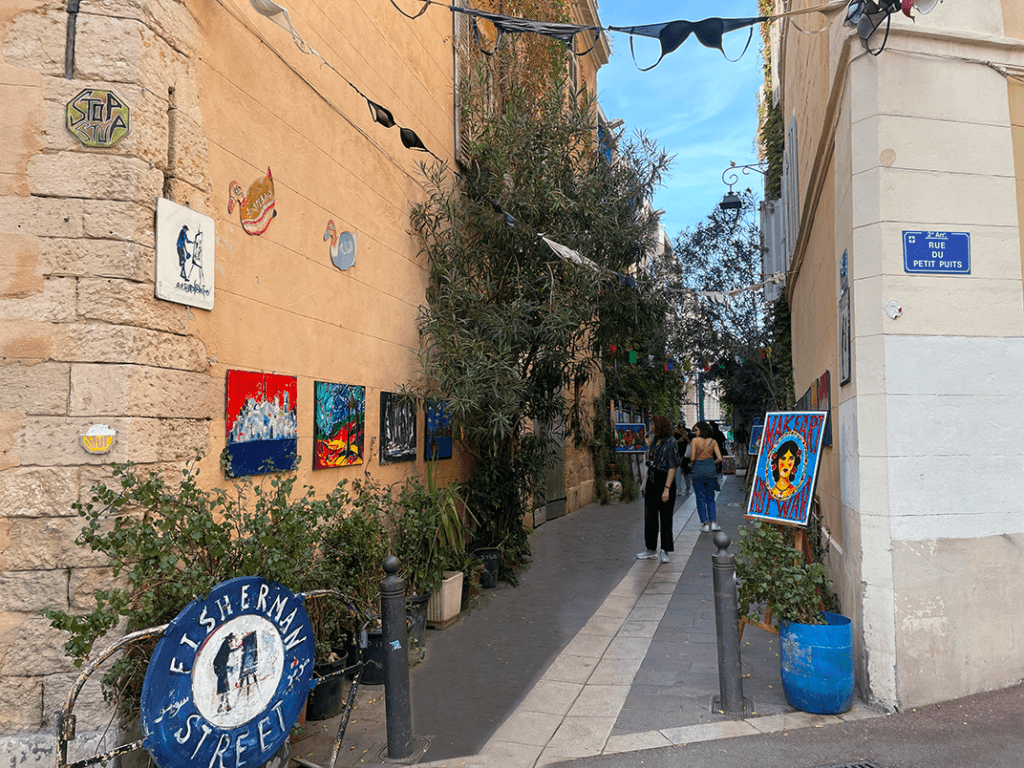
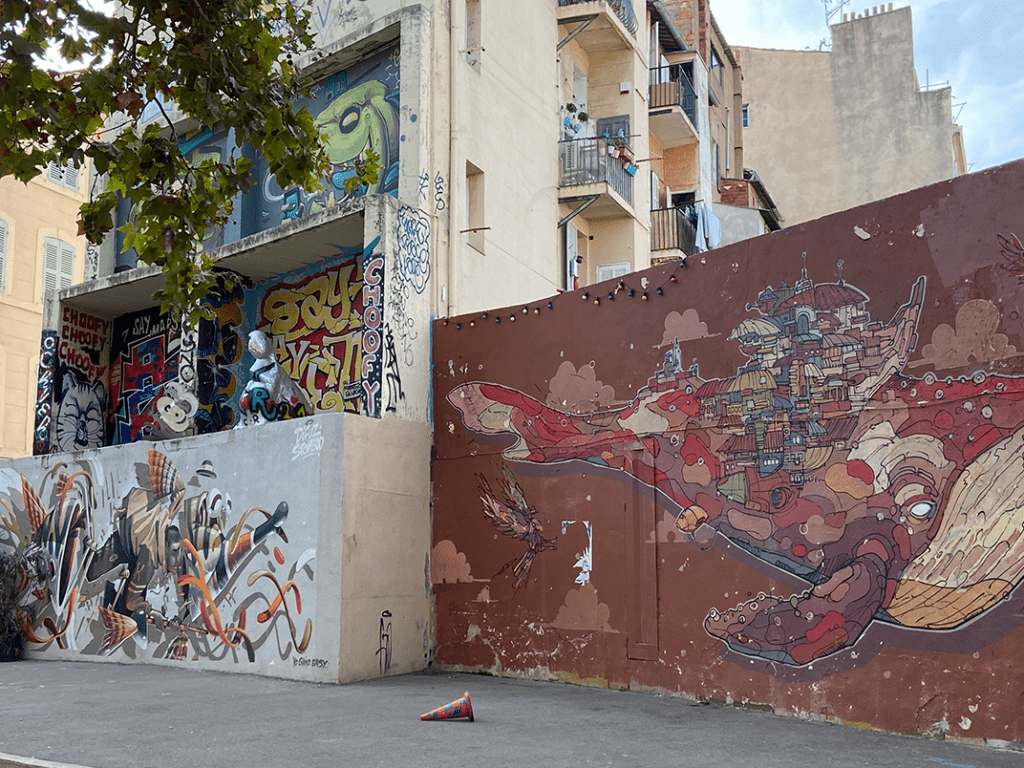
In the centre of the district is La Vieille Charité built by Pierre Puget (architect, sculptor, painter born here in the Panier in 1620). It was built following an Edict (1640) of the Commune of Marseilles to provide shelter for the city’s poor. The building, saved by Le Corbusier in the mid-1940s, now houses several small museums, completely free of charge, including a small Egyptian museum, a museum of African art, a bookshop and a café. Upon entering, one is welcomed into a symmetrical courtyard enclosed by galleries on three levels, which protect the oval-shaped chapel and Baroque dome in the centre. It is immediately striking for its peace and tranquillity, in stark contrast to the rest of the neighbourhood and the city.
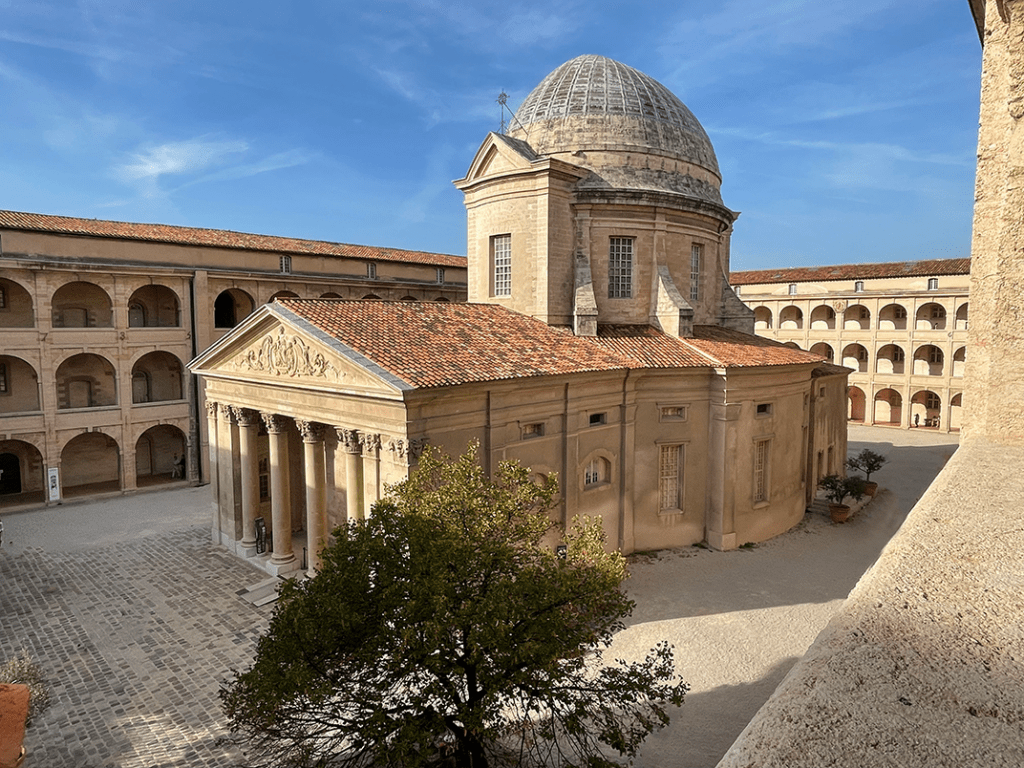
The next stop is Notre Dame de La Garde, we choose to reach it via the tourist train which allows us to take the scenic tour and also see the coast. We set off from the Old Port, passing by the Corniche promenade enjoying the splendid view of Fort Saint Jean and Fort Saint Nicolas, the Palais du Pharo, St Victor Abbey, the breathtaking panorama of the Pont de la Fausse Monnaie, the Château Valmer or the famous Vallon des Auffes. In the distance, we admire the Frioul Islands and the If Castle. We turn towards the Vallon de l’Oriol, where we pass the Marseille mansions perched along the hillside.
We finally arrive at an altitude of 162 metres, where Notre Dame de La Garde awaits us and an extraordinary panorama, with a 360° view of the entire city. The basilica is in the Neo-Byzantine style. It is accessed by a long flight of steps and is topped by a 60-metre-high bell tower with a statue of the Virgin and Child – the work of sculptor Eugène-Louis Lequesne – who the people of Marseilles call the ‘good mother’. Inside, there is a single nave covered by a ribbed vault with side chapels. The apse is square and surmounted by a dome. In the centre, on the high altar, is a statue of the Dame de La Garde.
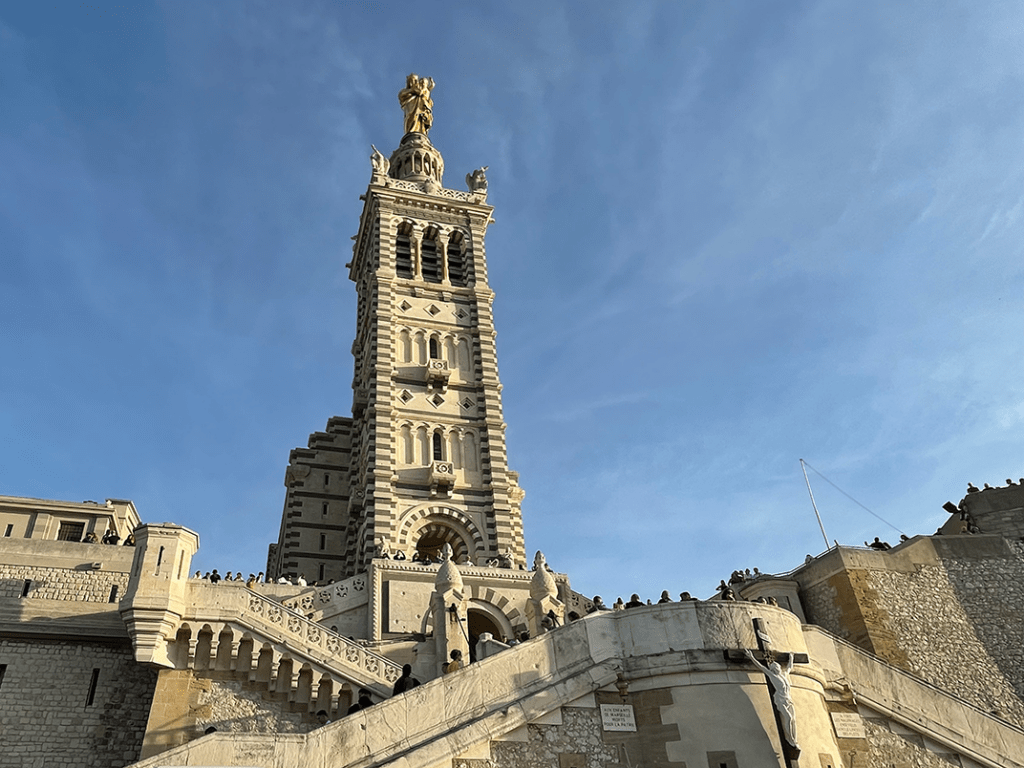
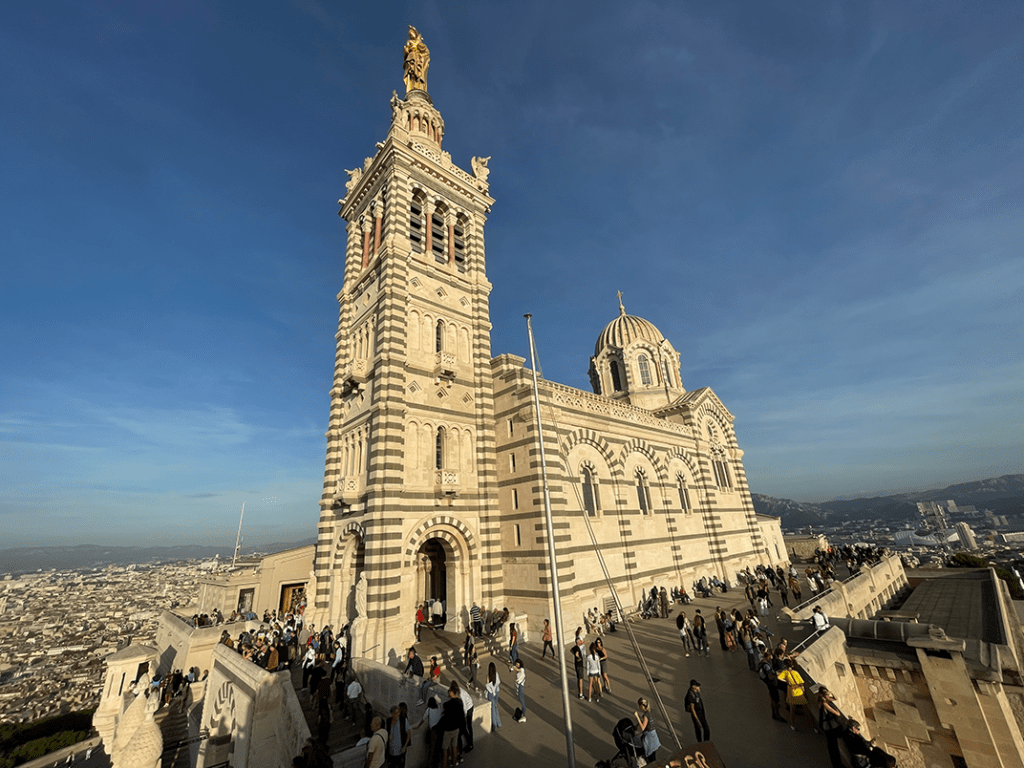
We return to the harbour area in the late afternoon and walk along the famous Rue La Canebière, the main street that runs through the historic centre of Marseille, from the Old Port to the Réformés quarter. At the end of the street is the Church of St Vincent de Paul, in its splendid white Gothic style. Its 70-metre-high bell towers tower above the roofs of the city and are visible along the start of the street.
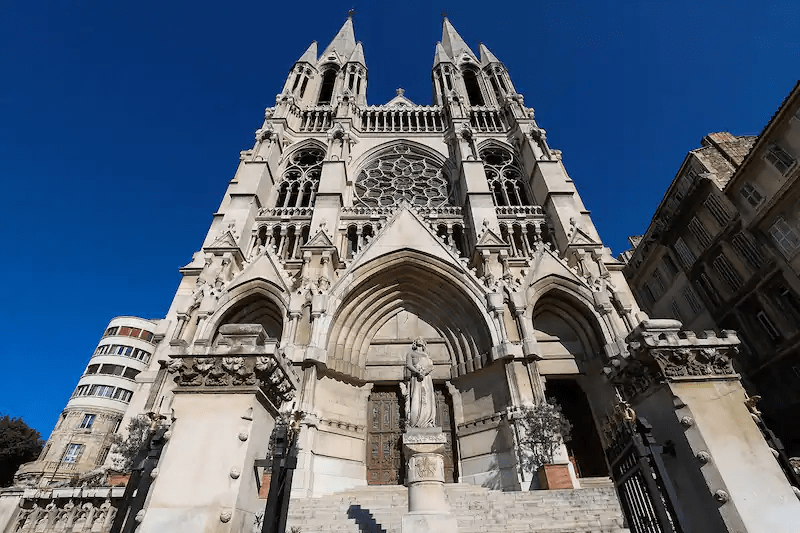
We treat ourselves to an aperitif, strictly Pastis, and end the evening with a typical dinner and good wine at Place Thiars’ fountain, full of lights and voices and warm colours.
Day 3: Aix-en-Provence
Today we stop in the city that is hosting us during this stay in Provence. The capital of Provence, Aix-en-Provence is a refined town, known for its fountains (more than a hundred, they say), with a very rich architectural and artistic heritage, and in particular the city of Paul Cézanne.
Our route begins at Place Saint-Jean-de-Malte (because it was the closest stop to the only car park we could find on this sunny and festive Monday in October). Here stands the Church of Saint-Jean-de-Malte, the first Gothic church in Provence, built between 1272 and 1277. Its bell tower rises to a height of 67 metres and is the highest point in the town. Adjacent to the church is the Granet Museum, which we did not visit because it is closed – like practically half of the places we wanted to visit, the French take the history of holiday bridges seriously – but I know that it has a remarkable collection of paintings and sculpture. The chapel inside houses ‘Granet XX’, a recurring exhibition displaying many contemporary works, notably works by Picasso and Kandisky.
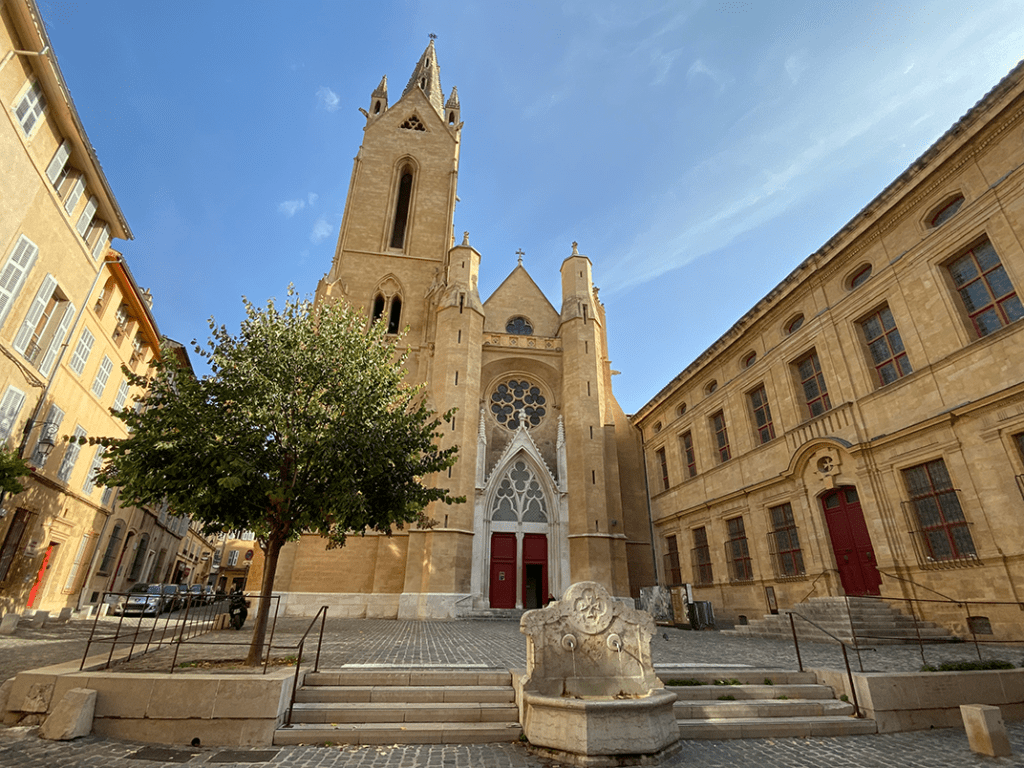
We walk along the centre and pass the Church of the Magdalena, dating from the 19th century, of which only the façade can be admired as it is closed for renovation and stabilisation work. In its square stands the Fontaine des Prêcheurs, consisting of a narrow, square basin with a low rim. In the centre is an imposing obelisk decorated with draperies.

We visit the Cathédrale de Saint-Sauveur, the main place of worship in Aix-en-Provence. Erected on the site of an ancient pagan temple dedicated to Apollo and later the cathedral of Saint Mary Major, it was built in two phases: Romanesque between the 11th and 13th centuries, and Gothic in the 16th century. From the rich and imposing Gothic portal, which reaches over twenty metres, the cathedral has numerous spires and decorations, which also affect the large bell tower (70 metres high) and the interior, which is in clear traditional Gothic style. In contrast to the Gothic exterior style, a beautiful Romanesque-style cloister can be visited inside.

We pass the cathedral and continue walking until we exit the old town and ascend the hill along Pasteur Street. At number 8, inside a courtyard, we come across the Joseph Sec Monument, an imposing allegorical monument, also known as the Joseph Sec Mausoleum, dedicated to the city’s ‘law-abiding’ municipality.
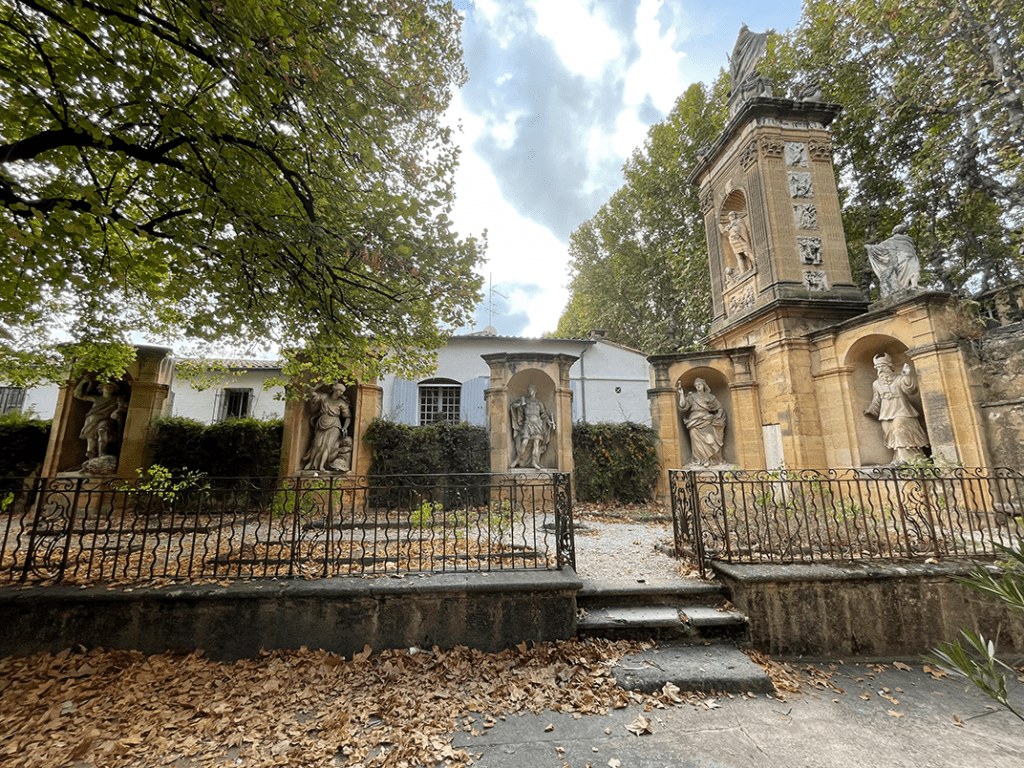
We continue up the hill and after a 10-minute walk we arrive atCézanne’s Atelier, where Cézanne himself worked during the last four years of his life, from 1902 to 1906. The building is surrounded by greenery, the atmosphere is one of absolute peace and it is easy to understand why the painter was so fond of this place. Unfortunately, we find the atelier closed – here we go again – but we read that it is a fifty-square-metre room, lit by a large window, where everything has remained unchanged since the painter’s death: brushes, paints and a huge mechanical easel that Cézanne himself had built to support the larger paintings.

We make our way to the Pavillon de Vendôme, a historic building, constructed in the second half of the 17th century to a design by Antoine Matisse at the behest of the Duke of Vendôme Louis de Mercoeur, who wanted to have a ‘folie’ built, a structure that included a monumental palace surrounded by large gardens (also called a capriccio). Needless to say, we also find this closed. We spend some time in the magnificent French-style garden that surrounds it and admire its façade with baroque Atlantean ornaments, fruit garlands and a mascaron.

We return towards the centre that it is lunchtime. We stop at the Place des Cardeurs. The square originated in 1963 following the demolition of an unhealthy block of houses. Over time, the space was rehabilitated and divided between three natural stone platforms. The place has been filled with restaurants and dehors that transform the appearance of the square, giving it a special atmosphere on still warm autumn days, when the restaurant terraces are full of people.
We stop at Place de l’Hôtel de Ville, in the heart of the pedestrian zone. The square houses the town hall inside a classical-style building decorated with wrought-iron grilles in the small balcony above the entrance, where flags are also on display. Adjacent to the town hall is the Clock Tower which, in addition to a clock and sundial, can also indicate the season in which you are. Occupying the centre is the Fontaine de l’eau Bénite built in 1755, surmounted by a Roman column that completes the beautiful Provençal postcard represented by this square.
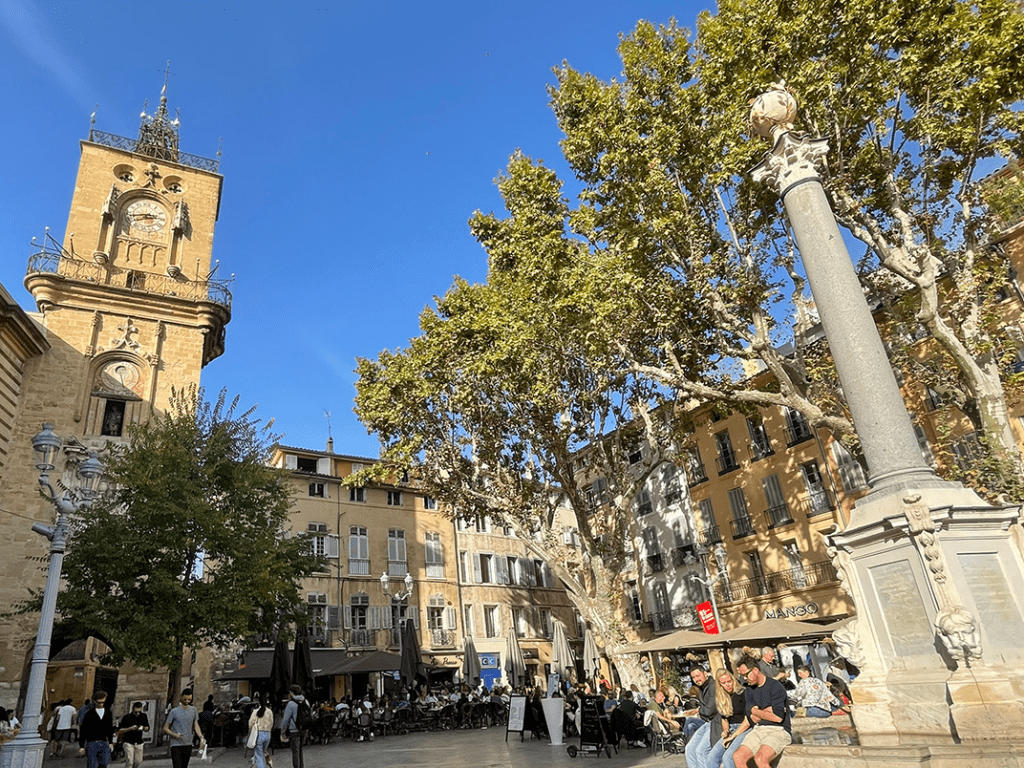
Of the many fountains in Aix, the most famous is certainly the Fontaine de la Rotonde on Place de Gaulle. It was built around the second half of the 1800s to celebrate the arrival of water in the city. At the top are three marble statues of women – which is why it is also called the fountain of the three graces – allegorical figures representing the three most important centres of Provence: Marseilles symbol of Agriculture, Aix-en-Provence symbol of Justice and Avignon symbol of Fine Arts.
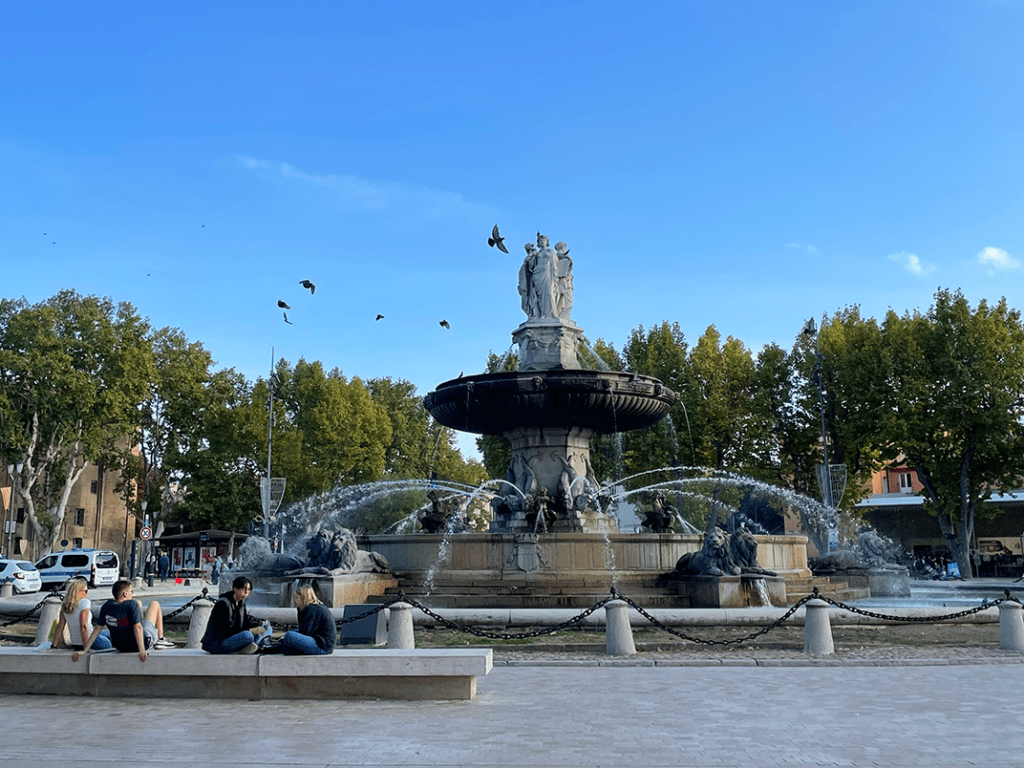
This is where Cours Mirabeau starts, dividing the new city from the old and representing one of the city’s focal points. The beauty of the avenue also lies in the homogeneity of the materials of the façades of the various buildings built using the same warm-coloured stone and decorated with wrought-iron balconies and Baroque-style ornaments. There are three beautiful fountains on the Corso: the Fountain of the Nine Cannons, almost completely shrouded by vegetation that hides the sculptures, the Fountain of Hot Water, covered with moss – so much so that it is sometimes also called the Fountain of Moss – from which thirty-four-degree thermal water flows out, and the Fountain of Roi René, holding a bunch of nutmeg grapes – because it was he who introduced this variety of grape to France – at the end of the Corso. Not far from Course Mirabeau is Place des Quatre-Dauphins, considered the oldest in the city.
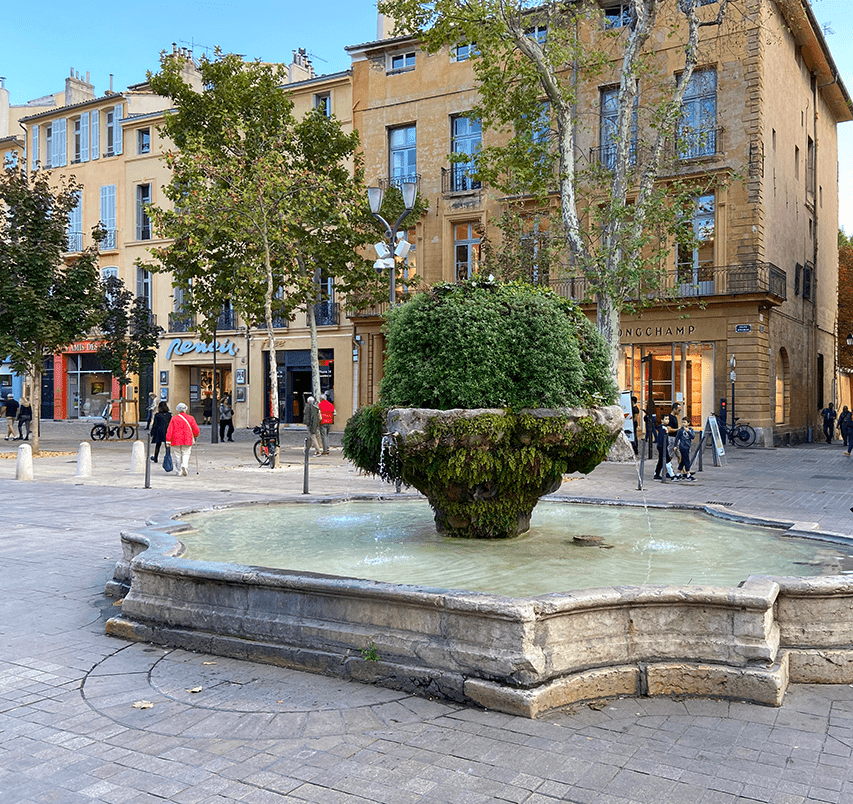
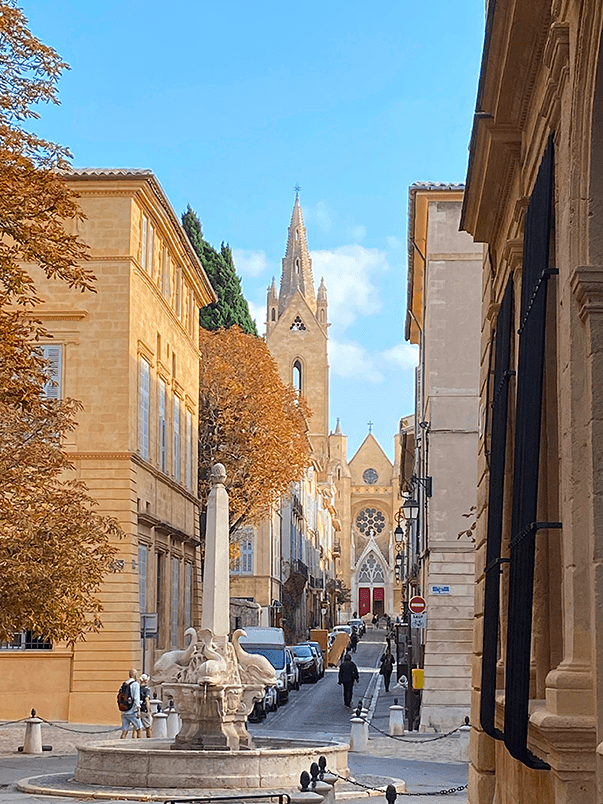
We end the day wandering around the city centre, admiring the views and alleyways that open onto small squares alive with bars, restaurants and shops of all kinds. Here, the Provençal atmosphere can be felt in the architecture of the buildings and in the typical products that each shop displays.
Day 4: Antibes
On our way home, we make one last short stop in the small town of Antibes. Situated high above the sea, you only have to walk through its colourful alleyways, full of flowers and artisans’ shops and the large lively market to be impressed by its picturesque charm.
Strolling through the old town, past small shops and tourists, we lose ourselves in a maze of streets, hidden alleyways and picturesque squares. We arrive at the Place Nationale and walk along the livelier streets rue Thuret, rue Clémenceau, rue Sade and Boulevard d’Aguillon and all the alleys around it.
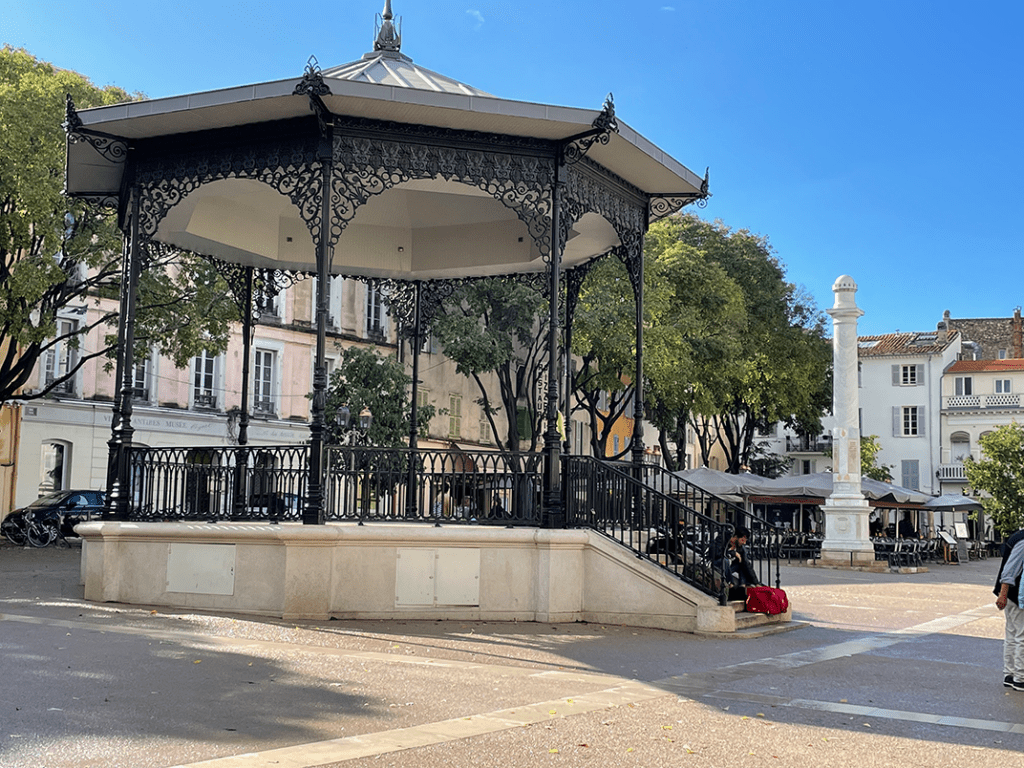
Attracted by the huge hubbub, we move on to the Provençal Market, which fills us with the smells and colours of festivity. From Tuesday to Sunday mornings, the Cours Masséna is filled with stalls of local producers offering the best of Provençal gastronomy, stalls of florists, horticulturists, fishmongers, pork butchers, cheesemakers and producers of Provençal handicrafts.
From a narrow street, we glimpse the Cathédrale Notre-Dame-de-la-Platea, which immediately catches the eye for the bright colours of its façade in typical Provençal Baroque style.
Continuing southwards, we visit the Free Commune of Safranier, founded in 1966 to preserve and perpetuate local traditions. Festivals such as the corn festival, the grape harvest festival in September, the chestnut festival in November and the stump festival in December are organised annually. The flower-lined streets of this small quarter are enchanting.
At the highest point of the ramparts stands Chateau Grimaldi. In the Middle Ages the residence of the bishops, it later became a town hall and was converted into barracks. Today it is home to the Picasso Museum which – guess what? – we find closed. In 1946, Pablo Picasso used part of the building as a workshop. From the château’s terrace, it seems, there is a magnificent view of the sea and Cap d’Antibes.
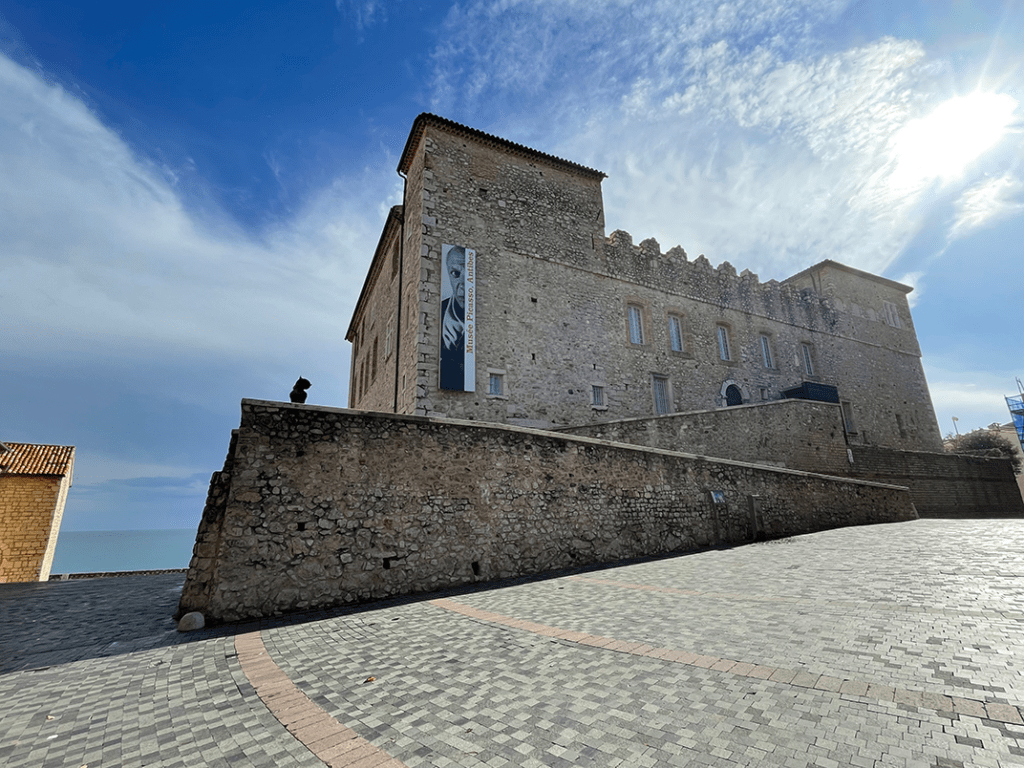
From the Picasso Museum, we walk along a wonderful promenade that follows the ancient walls, the Promenade de l’Amiral de Grasse: following the road we admire glimpses of the city overlooking the sea. From the ramp of Saleurs, where fish were salted in the past, we walk along the sea, following the path of the ramparts.
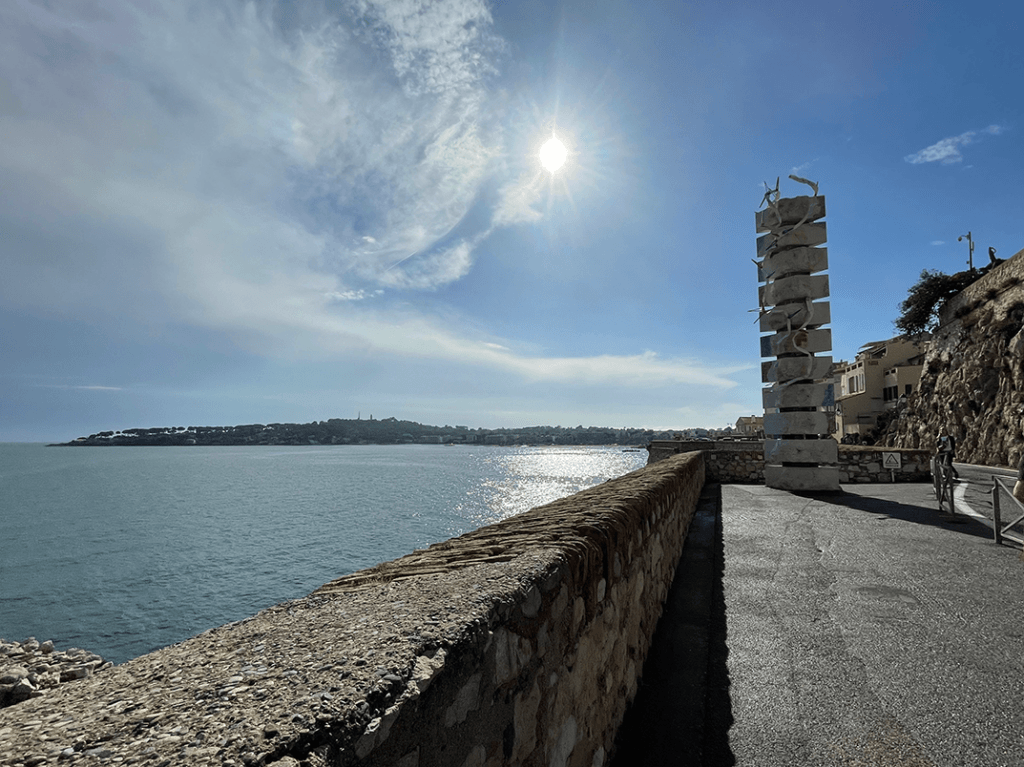
After this wonderful walk, it is time to get back in the car and head home. We tick Provence off our Travel Bucket List but keep the idea of returning there because there is still so much to see in this beautiful area.
Last modified: 14 June 2025

